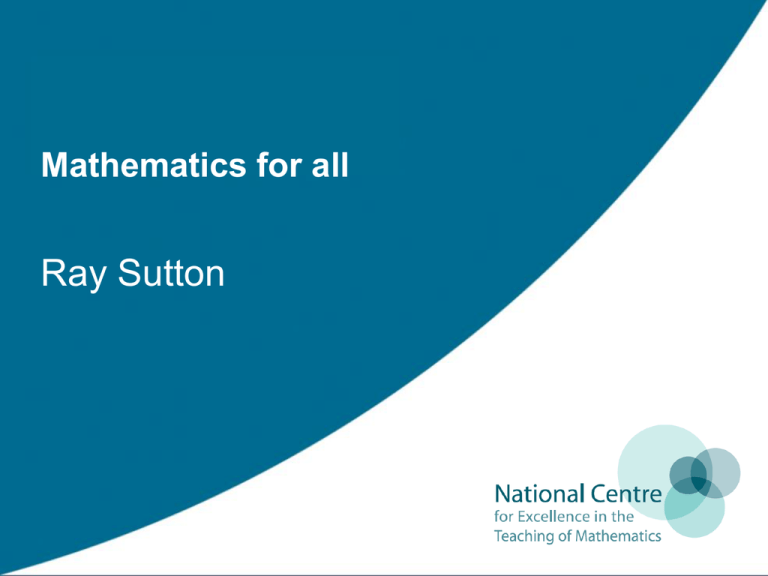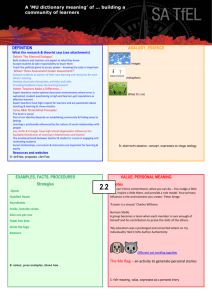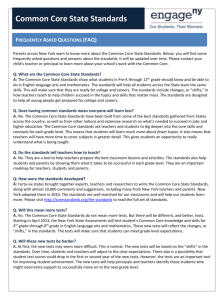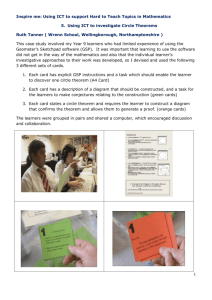Principles for effective teaching and learning in mathematics(1)
advertisement

Mathematics for all Ray Sutton What questions would you ask about the birth month display? What follow up activities would you plan? Objectives and programme To experience some activities that can be adapted to motivate mathematics learners of any age (9.30-10.45) To consider how challenge and progression can be compatible with fun and enjoyment (10.4512.00) To renew a commitment to professional learning (12.00-12.30) Pressing the right buttons Poster Pictures and stories Piece of A4 paper People maths Putting things in order Pay off for me Play dough www.problempictures.co.uk/examples The things you see! 3 00 4. What is good about these activities? Principles for effective teaching and learning in mathematics(1) builds on the knowledge learners already have This means developing formative assessment techniques and adapting our teaching to accommodate individual learning needs (Black and Wiliam, 1998). uses cooperative small group work Activities are more effective when they encourage critical, constructive discussion, rather than argumentation or uncritical acceptance (Mercer, 2000). Shared goals and group accountability are important (Askew and Wiliam, 1995). exposes and discusses common misconceptions Learning activities should expose current thinking, create ‘tensions’ by confronting learners with inconsistencies, and allow opportunities for resolution through discussion (Askew and Wiliam, 1995). - From Maths4Life ‘Thinking Through Mathematics Creating comfortable challenge Circles Cards Calculations Cubes Comparing methods Complete planning Creating comfortable challenge(2) Pushing for new language and description Thinking while doing Writing things down Adding a new twist or different dimension Collaborating and comparing Creating questions for one another Explaining why and giving reasons Choose any three digit number. Multiply by 7 Multiply by 11 Multiply by 13 Compare with your neighbour. What do you notice? Why? Principles for effective teaching and learning in mathematics(2) uses higher-order questions Questioning is more effective when it promotes explanation, application and synthesis rather than mere recall (Askew and Wiliam, 1995). encourages reasoning rather than ‘answer getting’ Often, learners are more concerned with what they have ‘done’ than with what they have learned. It is better to aim for depth than for superficial ‘coverage’. uses rich, collaborative tasks The tasks we use should be accessible, extendable, encourage decision making, promote discussion, encourage creativity, encourage ‘what if’ and ‘what if not?’ questions (Ahmed, 1987). creates connections between topics Learners often find it difficult to generalise and transfer their learning to other topics and contexts. Related concepts (such as division, fraction and ratio) remain unconnected. Effective teachers build bridges between ideas (Askew et al., 1997). uses technology Computers and interactive whiteboards allow us to present concepts in visually dynamic and exciting ways that motivate learners. What contributes to our professional learning? www.ncetm.org.uk The portal Self evaluation – subject knowledge, subjectspecific pedagogy Exemplification of LLUK standards Communities – especially ‘Focus on Numeracy’ in the East Midlands Subject Coaching Network community ‘Learning Mathematics outside the Classroom’, research, resources, blogs, news, events and much more. Be creative with.. ..organising learners and learning ..trying out new approaches ..variety in the lesson ..finding out what learners think ..making mathematics attractive ..supporting other teachers and assistants ..your own learning www.pims.math.ca/pi/cartoons.html - copyright W.Krawcewicz, University of Alberta ray.sutton@ncetm.org.uk









